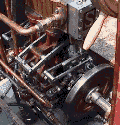
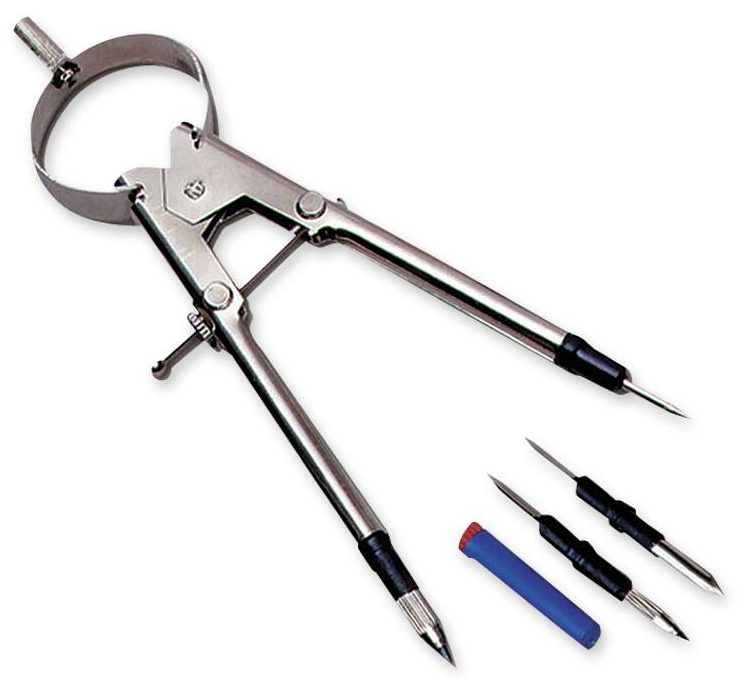

 Living
in a time when internal combustion engines (of many types) are every where, and even those are
being replaced by electric motors (run by power plants and batteries -- as in Hybrids and Electric Cars),
information on Steam Engines may be kind of hard to find, and may even
seem a silly thing to investigate. (Unless you've been watching reruns of, say, The Wild Wild West
where truly improbable things were done by Steam Power nearly every episode.)
Living
in a time when internal combustion engines (of many types) are every where, and even those are
being replaced by electric motors (run by power plants and batteries -- as in Hybrids and Electric Cars),
information on Steam Engines may be kind of hard to find, and may even
seem a silly thing to investigate. (Unless you've been watching reruns of, say, The Wild Wild West
where truly improbable things were done by Steam Power nearly every episode.)
As is Hollywood's way, much of what was portrayed as "steam powered" in that program was simply impossible. Here we're going to talk about what "steam" really is and what it can actually do, which, frankly, is pretty darn amazing in itself, without resorting to "spy-fy" (as such programs were called), or outright fantasy.


FLYER 24' LOA, 5HP engine
The epitome of a classic steam launch, built from all modern materials and techniques

The revival of small steamboats began in the 1950's and was primarily among people who were interested in a creative mechanical hobby - similar perhaps to classic car restoration; but more practical and fun for the family than, say, model trains. The boat or hull was little more than a floating platform for the center of interest - the steam power plant. This remains so today! Even in the best designed and most aesthetically pleasing steamboats, the focal point is the power plant. To this end, a rudimentary knowledge of what "makes the propeller go 'round" is necessary.
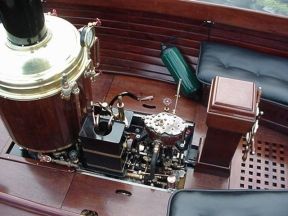 Since early times steamboats have used a very wide variety of engine and boiler
types. There is no such thing as a "typical" small steam boat. And while in major population centers, steam
launch builders created "stock models", once outside these urban areas the hull design and materials of
construction, as well as the power plant were dictated by several factors: the location of operation (lake,
river...); availability of machinery (many early engines and boilers were crudely built by local foundaries);
and the depth of the owner's wallet. This is still true.
Since early times steamboats have used a very wide variety of engine and boiler
types. There is no such thing as a "typical" small steam boat. And while in major population centers, steam
launch builders created "stock models", once outside these urban areas the hull design and materials of
construction, as well as the power plant were dictated by several factors: the location of operation (lake,
river...); availability of machinery (many early engines and boilers were crudely built by local foundaries);
and the depth of the owner's wallet. This is still true.
The oft spoken "simplicity" of a steam engine is a myth.
Most steamboat engines have as many moving parts as any two-cycle gas engine.
The advent of onboard computers and sophisticated black boxes in consumer autos has taken all the
hands-on fun out of maintaining your own car. In fact, you can't. Steam Engines and Steamboats are
still hands-on, and that, to me, is one of their most endearing values.
A person handy with his (her) hands and tools can still have a fine, quality, constructive hobby.
So, while it's simplicity might be a myth, it is all the same one Great Hobby.
What else you need to know?
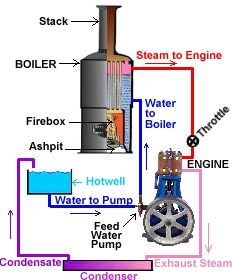 You boil water*
in a boiler, thereby producing steam under pressure.
The steam is transferred via a pipe to the engine where a valve admits steam to the engine's
cylinder at appropriate intervals, thereby pushing a piston up and down. Through a connecting rod
this motion is transferred to a crankshaft which revolves and so turns a propeller (in the case of
a boat, say; in the unlikely case of using steam to power a giant spider's arm, in the case of
Dr Loveless in the Wild Wild West you would need a different mechanism).
Regardless of how you turn it into useful work, the result is a mass of metal moving rhythmically in a
cyclic fashion, and that's then easy to turn into usefulness.
You boil water*
in a boiler, thereby producing steam under pressure.
The steam is transferred via a pipe to the engine where a valve admits steam to the engine's
cylinder at appropriate intervals, thereby pushing a piston up and down. Through a connecting rod
this motion is transferred to a crankshaft which revolves and so turns a propeller (in the case of
a boat, say; in the unlikely case of using steam to power a giant spider's arm, in the case of
Dr Loveless in the Wild Wild West you would need a different mechanism).
Regardless of how you turn it into useful work, the result is a mass of metal moving rhythmically in a
cyclic fashion, and that's then easy to turn into usefulness.
There are practical details of equipment and operation which can be learned
over time. It is not necssary to know the more esoteric concepts in design and thermal efficiency
to sucessfully, and pleasureably, operate a small steamboat.
*

 NOTE: that (boiling water) is just one method. There are other things to "boil" than water
to drive a steam engine, and for that matter, other ways to heat them than with fire
(you could use a dragon, say, or a solar heat collector, or even a nuclear pile), but
that's close enough for our purposes here.
NOTE: that (boiling water) is just one method. There are other things to "boil" than water
to drive a steam engine, and for that matter, other ways to heat them than with fire
(you could use a dragon, say, or a solar heat collector, or even a nuclear pile), but
that's close enough for our purposes here.
By The Way: Did you know that ultimately, a Nuclear Power Plant is a giant steam turbine,
the nuclear fuel providing heat to make steam? Nothing more complex than that!
Nothing "Star Trek-ish" or "particle physics-ish" at all. A nuclear pile isn't magic; just hot.
1. the "Fire", 2. the Boiler, and 3. the Engine.
 The Fire is contained in a
firebox (or furnace). If solid fuel is to be burned, there must be a grate to support the fuel so that air
can reach it. The space under the grate is called the ashpit. Large quantities of air are needed to support
combustion. This draft should enter through the ashpit door and flow UP THROUGH the fire. If liquid or gas
fuel is used, there is no grate or ashpit and the air generally enters in a fashion similar to the oil or
gas burner of a home furnace.
The Fire is contained in a
firebox (or furnace). If solid fuel is to be burned, there must be a grate to support the fuel so that air
can reach it. The space under the grate is called the ashpit. Large quantities of air are needed to support
combustion. This draft should enter through the ashpit door and flow UP THROUGH the fire. If liquid or gas
fuel is used, there is no grate or ashpit and the air generally enters in a fashion similar to the oil or
gas burner of a home furnace.
Note: a 2HP steam engine suitable for an 18' steamboat will burn the equivalent of
1 gal. of furnace oil per hour - 135,000 BTUs: 3x the heat ["energy"] output of the average
home furnace when running flat out!
The Boiler holds a quantity of water in such a way that most of the heat from the fire can be transferred to the water. The water boils and gives off steam under pressure, so the boiler has the double purpose of transferring heat and containing pressure. The greater the surface area exposed to the fire, the more heat can be transferred to the water (and the less wasted up the stack), and the more steam produced. The best way to create this large surface area in a small space is to fill the space with pipes, or tubes. Therefore the heating surface of all steamboat boilers is made up primarily of tubes.
For more about Boilers and a free downloadable eBook (courtesy of Google Books), written in 1903, and really nice for filling in your basic knowledge of steam and steam boilers, and for filling in some of the essential physics they did not teach you in high school but should have, click here .
Boilers are described as firetube and watertube, depending on whether the hot gases from the fire pass through the tubes, or the water is contained in the tubes and the hot gases pass around them.
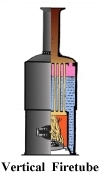 Firetube Boilers are basically a cylindrical shell, or drum, with a top and a bottom plate and the tubes passing
between; under full pressure and usually holding a large quantity of water. Thus it holds a great energy
reserve in the heated water, permitting steady steaming even with fluctuations in the fire. A firetube boiler
is slow to raise steam, even in small sizes, and holds great potential, in the large mass of stored energy,
for a lethal explosion if not properly built and maintained. It is, however, easier and cheaper to build and,
if constructed to ASME (American Society of Mechanical Engineers) code with annual testing to
NBIC (National Board Inspection Code) standards, fully as safe as a watertube boiler.
Firetube Boilers are basically a cylindrical shell, or drum, with a top and a bottom plate and the tubes passing
between; under full pressure and usually holding a large quantity of water. Thus it holds a great energy
reserve in the heated water, permitting steady steaming even with fluctuations in the fire. A firetube boiler
is slow to raise steam, even in small sizes, and holds great potential, in the large mass of stored energy,
for a lethal explosion if not properly built and maintained. It is, however, easier and cheaper to build and,
if constructed to ASME (American Society of Mechanical Engineers) code with annual testing to
NBIC (National Board Inspection Code) standards, fully as safe as a watertube boiler.
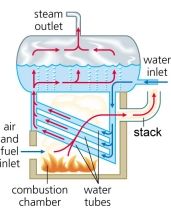 Watertube Boilers consist of an open arrangement of tubes, connected to pressure drum(s).
The tubes are arranged to encourage rapid circulation of the water, thereby distributing the fire's heat
evenly and allowing greater heat transfer for a given surface area than is possible, or desireable, in a firetube
boiler. A general rule of thumb is: for a given surface area a watertube boiler will produce TWICE as much
steam as a firetube boiler. The danger of explosion is greatly reduced due to the decreased quantity of water
held and the small size of the pressure drum(s). Watertube boilers must be fully enclosed in a casing strong
enough to support the weight of the boiler, and well insulated to prevent the loss of heat. They are, as a
general rule, more difficult and expensive to build.
Watertube Boilers consist of an open arrangement of tubes, connected to pressure drum(s).
The tubes are arranged to encourage rapid circulation of the water, thereby distributing the fire's heat
evenly and allowing greater heat transfer for a given surface area than is possible, or desireable, in a firetube
boiler. A general rule of thumb is: for a given surface area a watertube boiler will produce TWICE as much
steam as a firetube boiler. The danger of explosion is greatly reduced due to the decreased quantity of water
held and the small size of the pressure drum(s). Watertube boilers must be fully enclosed in a casing strong
enough to support the weight of the boiler, and well insulated to prevent the loss of heat. They are, as a
general rule, more difficult and expensive to build.
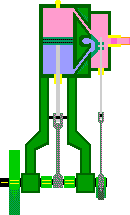 The Engine
When the steam reaches the engine, its admission to the cylinder to push the
piston up or down must be controlled. A valve, usually moved by the engine crankshaft through an eccentric
(much like the camshaft on an automobile), moves back and forth across a valve face to admit steam through
ports to the cylinder and to exhaust the spent steam to the atmosphere or into a condenser. The valve is connected
to the eccentric by an eccentric rod (similar to the "push rod" on an internal combustion engine). The valve may
be a flat, rectangular affair - called a D or slide valve. Or it may look like a thread spool and move in a
cylindrical chamber and be called a piston valve.
The Engine
When the steam reaches the engine, its admission to the cylinder to push the
piston up or down must be controlled. A valve, usually moved by the engine crankshaft through an eccentric
(much like the camshaft on an automobile), moves back and forth across a valve face to admit steam through
ports to the cylinder and to exhaust the spent steam to the atmosphere or into a condenser. The valve is connected
to the eccentric by an eccentric rod (similar to the "push rod" on an internal combustion engine). The valve may
be a flat, rectangular affair - called a D or slide valve. Or it may look like a thread spool and move in a
cylindrical chamber and be called a piston valve.

Most marine steam engines are Double Acting. The steam alternately pushes against each side of the piston, so there are two power strokes per revolution of the crankshaft. This is one advantage of steam over internal combustion - a single cylinder steam engine supplies the same turning effort as a 4 cylinder (4 cycle) gas engine of equal dimensions and cylinder pressure. This does, however, result in some additional complications. A piston rod slides through a packing gland which prevents pressure from leaking through. The piston rod is then connected to a crosshead, to which the upper end of the connecting rod is also joined. The crosshead is prevented from moving from side to side by the crosshead guides. The pieces of the engine are mounted on a bedplate which is in turn secured to the hull.
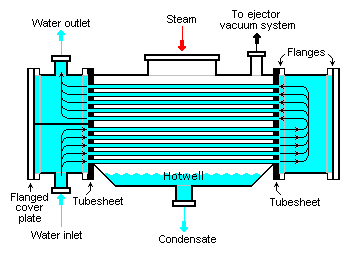 The Condenser (Yes, that's a "fourth" component
in this list of three. Deal with it.)
The Condenser (Yes, that's a "fourth" component
in this list of three. Deal with it.)
In marine applications, a condenser is usually used, allowing the water to be recovered for re-use (putting
salty or dirty water into a boiler will destroy it and the engine quickly). The condenser is nothing more
than a piece of copper tubing fastened to the side of the keel.
The condensed steam - now water
[Dead Steam as it was put in the movie the Sand Pebbles, 1966]
- is returned
to a holding tank called a hotwell. Water is drawn from the hotwell and pumped to the boiler by a feed water
pump, usually driven by the engine so that the quantity of water provided is proportional to its use - as
steam
[Live Steam as per the Sand Pebbles]
- by the engine. There will be other ways of getting water into the boiler, such as a hand operated feed
pump or an injector, say, should the engine-driven pump fail.
For an example of a condenser, look at
one of ours here.

Original Steam Powered Evil Genius.
You might say, the first Steam Punk
(and a Cool Actor)
Answer Here
(Remember the scene in Titanic where the chief engineer is reversing the engines for the impending collision? It's quite accurately done, really, and a very nice piece of movie work. Of course, those were industrial sized steam engines, not a family-sized river boat engine; for hobby steam, it's all very, very simple.)


Yet, it didn't go commercial (as we might say today) for nearly 1700 years. Go figure...
The book Ancient Inventions (Peter James & Nick Thorpe, 1994) actually has a very nice speculative article discussing whether the Roman Empire might have had all the pieces to create a steam-powered military tank (automated "turtle" it would have been to them), and why they [probably] did not notice that piece of world-history-changing technology that was within their grasp.
You can start with Our Own Resources Page, lot's of Internet Links to cool places to visit.
You should also (most definitely!) visit our Frquently Asked Questions (FAQs) page
 Heron of Alexandria 10AD - 70AD |
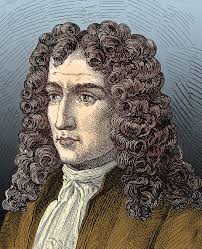 Denis Papin 1647 - 1713 |
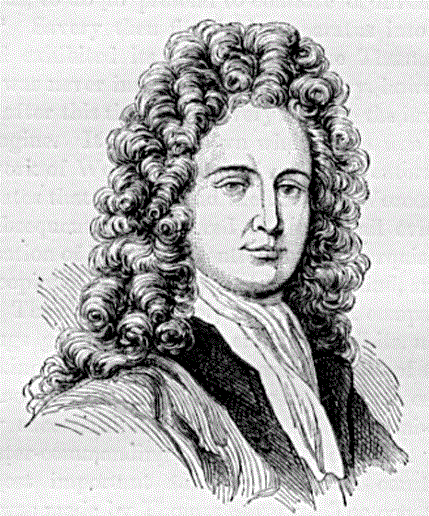 Thomas Savery 1650 - 1715 |
 Thomas Newcomen 1664 - 1729 |
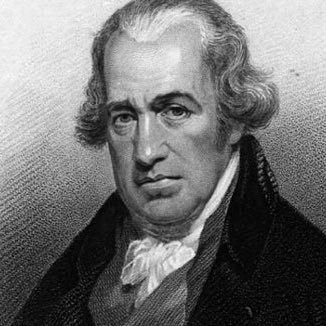 James Watt 1736 - 1819 |
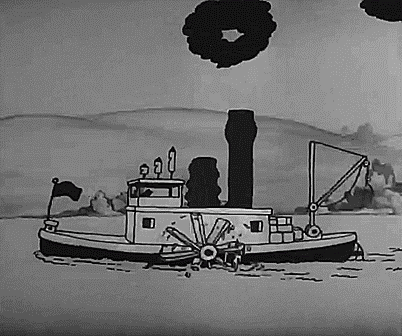
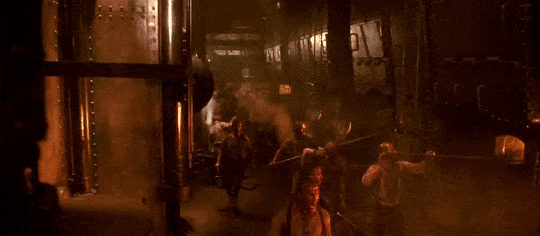
it's actually from James Cameron's 1997 block-buster Titanic,
which offered some outstanding visuals of Steam Power during its heyday.
(It's an immediate download, on clicking)
All you've ever needed to know about steam but were afraid to ask https://ir.library.oregonstate.edu/downloads/vd66w122v
| Links | Home | FAQs |
The single cylinder engine animation is from the steamboat@rya-online animations page, and we acknowledge the copyright of Bob Shearer, its creator.





 We also accept
We also accept
